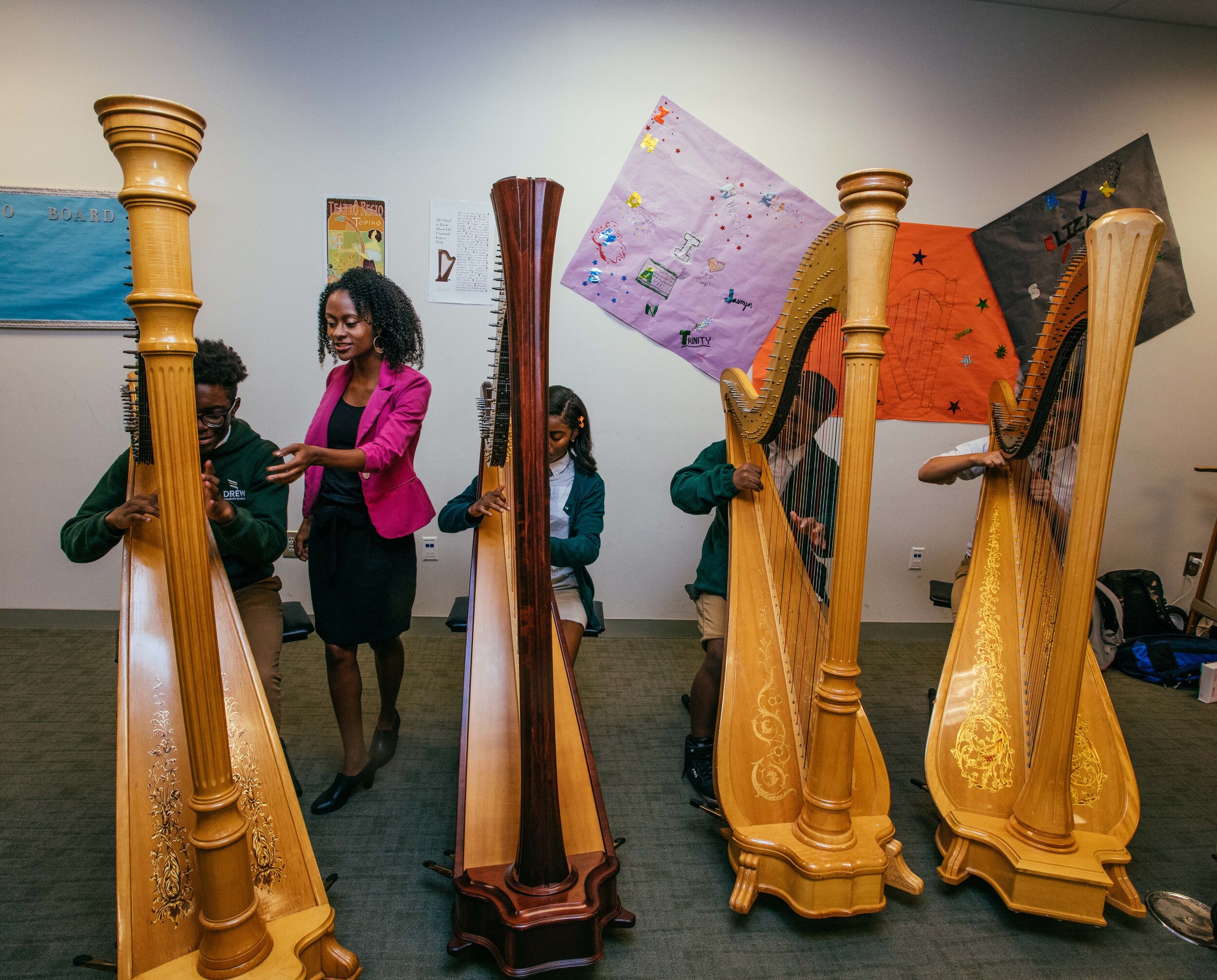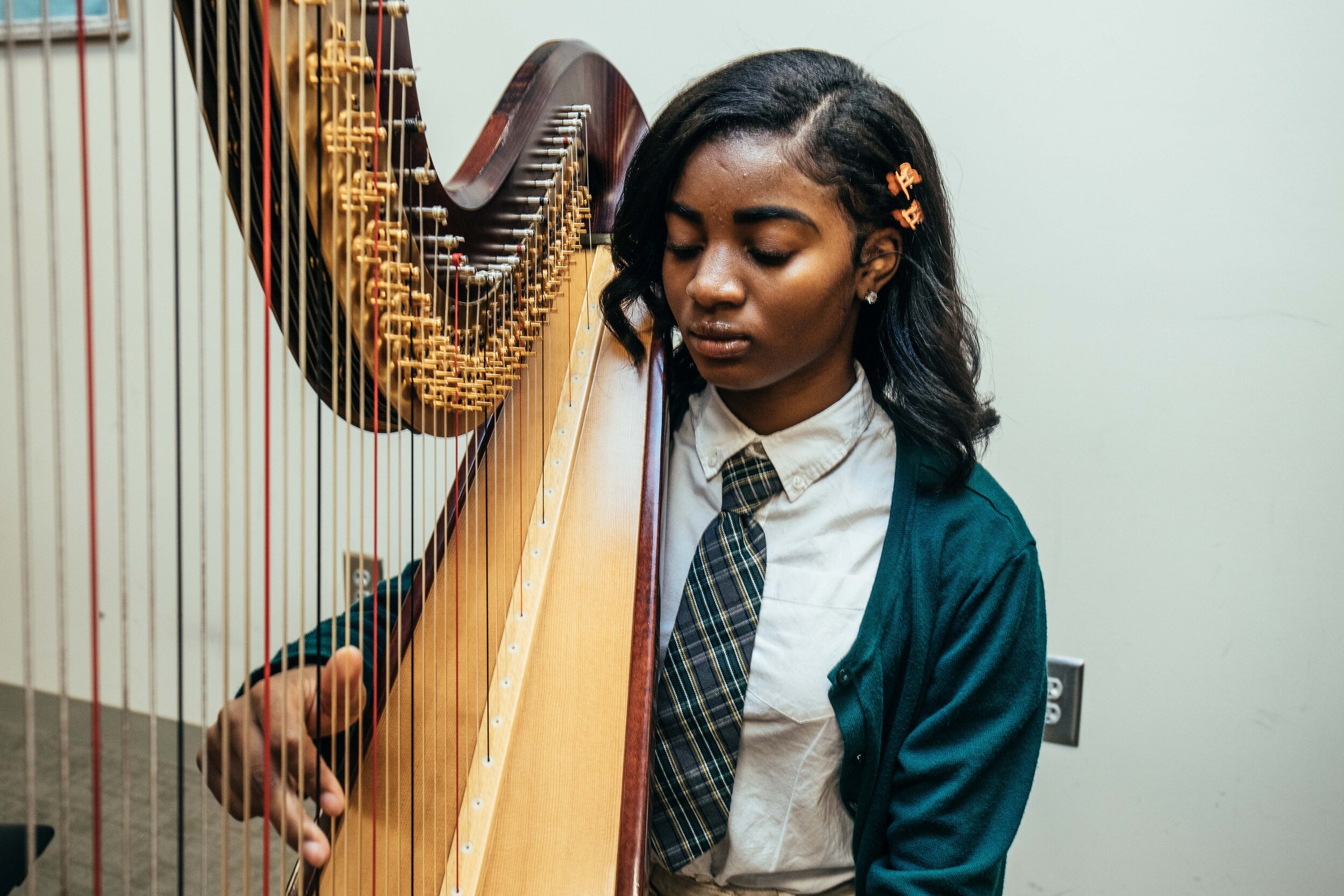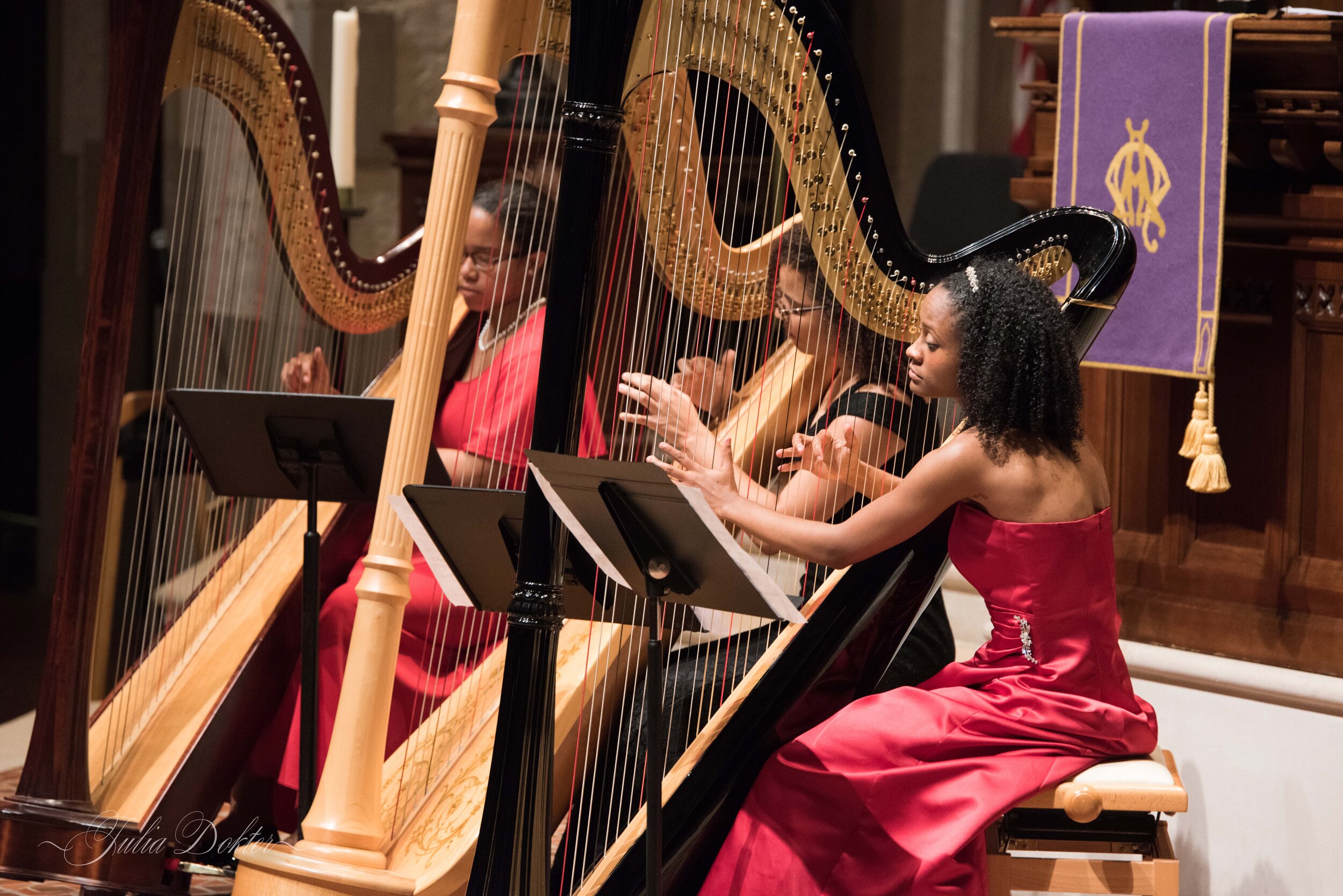Challenge the Stats Strikes a Chord

Harpist and social entrepreneur Angelica Hairston is forging a path in classical music for musicians of color
BY THE TIME CHALLENGE THE STATS founder and professional musician Angelica Hairston picked up a harp, she had already reached the ripe old age of 12, practically over the hill by professional standards, especially in classical music.
That she ascended to such great heights despite the late start is just one of the many remarkable facts distinguishing her career, not only as an artist but as a social justice entrepreneur.
Born in Burbank, Calif., Hairston moved with her family to Atlanta at age three, settling in the Chamblee-Tucker area and attending Chamblee Middle and High Schools.
She began playing music at four, starting on the violin because it was the easiest for her tiny hands to wield and because it didn’t require the hefty lung capacity necessary for the trumpet that her father played.
Angelica’s father was also a musician, a band teacher who could deftly pick up and play any instrument in a band room. Music “was just part of my blood,” Hairston said.
At age 12, Hairston’s life changed forever when she attended an Atlanta Symphony Orchestra (ASO) concert and got her first glimpse of the harp, which seemed to her like something out of a fairy tale. It was total, head-over-heels love at first sight.
“I just thought it was so majestic, so unique,” she said. “That giant instrument looks funky, and I’m kind of funky. I really wanted to get my hands on it.”
Her parents were understandably skeptical at first—after all, their enterprising daughter had already dabbled in figure skating, horseback riding, and myriad other activities that were just as quickly abandoned. “My parents thought, ‘Oh my gosh, here we go again,’” Angelica laughed.
Despite the enormous financial commitment that harp training required, her parents told their eager child that she could rent a harp for three months to see if it stuck. And stick it definitely did.
Now the 26-year-old Hairston serves as artistic director of the Urban Youth Harp Ensemble, a nonprofit organization that provides free harp instruction to more than 80 students in Atlanta’s inner city.
On top of that, she’s the founder and director of Challenge the Stats (CTS), a nonprofit that empowers artists of color “by creating communities devoted to diversity, inclusion, and equity in the classical performing arts.”
CTS, which launched in Boston in 2016 and Atlanta in 2018, holds concert series, educational workshops, and engaging community-based discussions that impact an estimated 950 artists and audience members annually.
Hairston’s Challenge the Stats launch at First Presbyterian Church of Atlanta in 2018 featured a brand-new piece, “Songs From Prison,” about the school-to-prison pipeline, composed by Emory alumnus Joel Thompson. Photo by Dr. Julia Dokter
She also holds a master’s degree in music industry leadership from Northeastern University and has performed concerts all over the country.
It’s a far cry from where she started, learning to play by ear before graduating to sheet music.
“I was always kind of playing catch-up in the harp realm,” Hairston said. Absorbing harp fundamentals at an accelerated pace required that she practice at least two hours a day and set up an extra class period during high school to practice.
That her life revolved completely around the art was just dandy; after all, music is almost like breathing to Hairston. Even today, when she’s not playing an instrument, she is listening to some piece of music that stirs her soul.
When Hairston got into the highly competitive ASO Talent Development Program, which she participated in for six years, it “really changed the trajectory of my life,” she said.
The ASO program gave Hairston an entree to resources she might not have had access to otherwise, and in many ways was an early foundation for her own nonprofit work down the road.
“How do we create these spaces where people who are so far apart from one another can then come together in unity and care, without uniformity?”
ANGELICA HAIRSTON
One of her first mentors, a teacher through the ASO program, was Elisabeth Remy Johnson, the ASO’s principal harpist, whose rigorous approach to tutelage molded Angelica’s fierce work ethic but also fostered something deeper—a determination not to take no for an answer.
“She knew I needed to have thick skin,” Angelica said. “So it was about making sure the notes were right and making sure that my playing was strong. But it was also about making sure that I could handle this field as a woman of color. She was very tough. She held extremely high expectations for me.”
One way this “tough love” approach manifested was during preparation for Angelica’s first summer at the prestigious Interlochen Center for the Arts, in Michigan, which was founded in 1928 and includes famous alumni like Sufjan Stevens, Josh Groban, and Norah Jones.
“I remember being really nervous, but I was deeply grateful for the ways that my teacher had prepared me. Even though I found myself near the bottom of the totem pole, in terms of level, Elisabeth had helped me develop resilience and a strong work ethic,” Hairston said. “I knew what it was to focus. I knew what it was to come to a lesson ready, and I knew how hard I’d need to work to get where I needed to be.”
Urban Youth Harp Ensemble student India Ingram is fully focused on learning harp technique. One of Hairston’s goals for her classes is to make music students of color feel seen and heard as musicians and artists.
Hairston learned that success in her field required not just the raw talent that she possessed but also the “motivation to continue to work and grow.”
Still, as a harp student of color, Hairston often felt isolated. She simply wasn’t surrounded by many peers who looked like her.
She had also noticed the chasm between her own middle-class upbringing and the immense economic privilege of her peers. The music camps that Hairston attended would have cost thousands of dollars if not for the support of the ASO program.
Just as the self-doubt was beginning to really gnaw at her, she had the chance one summer to attend the Boston University Tanglewood Institute in Lenox, Mass., and study with the legendary Ann Hobson Pilot, former principal harpist of the Boston Symphony Orchestra and herself a woman of color. It was a transformational experience.
“I remember sitting in this lesson with this incredible woman, who is playing with one of the top-tier orchestras in the entire nation. And she would reach over to play something on the harp, and her hand was the same color as mine,” Hairston said. “And her hair was curly and big and beautiful. And I remember finally feeling known and feeling seen just on a much more intimate level than I had ever experienced. It opened my eyes to the fact that someone had already opened doors for me at the highest performance levels."
Yo-Yo Ma, John Williams, and others have cited Pilot for her boundary-breaking legacy, but for Hairston, meeting Pilot marked a powerful moment of recognition, of seeing herself reflected in another artist who had “made it.”
“To say, ‘Yes, you have space in this field. There is space for you. You are welcome,’ is something I always try and replicate,” Hairston said. “I just think about ways in which my career now can have that same impact of opening doors for children who never thought that they could have access to this.”
Hairston was still very much on track to become a professional orchestral harpist when she heard the news in 2013 that George Zimmerman had been acquitted of Trayvon Martin’s murder. In her shock, something crystallized, and she knew she’d need to pivot.
“I remember sitting in a practice room and saying, ‘This is insane.’ And I’m sitting here practicing this really tough music to make it perfect. But—why?” she said. Soon, that bout of existential crisis morphed into motivation fuel.
“I knew I was interested in social justice and in classical music. Those two things are so far apart in many spaces, on sort of a sliding scale. But I wanted to find a way to intersect those two ideas,” she said.
Margo Saulnier, who taught arts planning and management at Northeastern University, remembers meeting Hairston, then a graduate student, around that time.
“I immediately knew I was in the presence of an extraordinary person,” Saulnier said. “She’s articulate, thoughtful, driven, engaging, charismatic—I could just list adjectives all day to describe her. And it was clear she had a commitment to make a difference with people of color and artists of color.”
For Hairston, Saulnier “was the first person who heard my whole story and said, ‘OK, I get it. Let’s figure this out. I don’t know what that looks like—this is not a path that is charted. But let’s do this together—let’s do a concert,’” Angelica said. “And what’s beautiful is, Margo is white, and she chose to use her classes to create this space where we could have real, honest, and often vulnerable conversations about race, equity, and creating sustainable change. She would open doors, create extra space, extra time, so I could get to the level of having trust in my own self.”
Under the advisement of Saulnier, Hairston pulled together an entire performance as her graduate thesis, which rapidly snowballed into a huge event in the music community of Boston.
“It was just going to be a little concert with friends, not a big deal,” Angelica remembers thinking at the beginning. She wanted to highlight composers of color who are often underrepresented in classical music and feature performers of color.
Everyone she approached rallied behind the idea—the NEU Music Department, the Fenway Center, the Museum of African American History, the NAACP, the John D. O’Bryant African American Institute, her classmates. “Every little detail was covered because people heard this crazy idea that didn’t make a lot of sense to me yet, but they believed that this was something that needed to happen.”
The evening was a smorgasbord of creativity, featuring speakers, youth from Project STEP, a training and development program for string players of color, an opera singer, a dancer, and even a film Hairston had commissioned, focused on the lives lost to police brutality, set to live music. An estimated 200 people showed up.
“The excitement and energy in the space just was extraordinary,” Saulnier said.
“It was very provocative. It made people very uncomfortable. Which I think is the goal oftentimes in these spaces,” Hairston said. “But it was so cool to see people continuing those conversations as they left and considering their role in advocating for change.”
Once Angelica graduated, she escaped the New England winters and immediately returned to her hometown, determined to keep the momentum going and continue building CTS. She just needed a space for their performances.
That’s when she met Jens Korndörfer, director of worship and the arts and organist at First Presbyterian Church of Atlanta, at a lunchtime concert Hairston gave at the church.
Afterward, the two chatted about CTS. “She told me in detail about what this organization is about, why she created all of these things. And I had no idea about the statistics actually,” Korndörfer said.
The stats that Hairston’s organization means to challenge, regarding artists of color within classical music, are daunting. According to studies cited on the CTS website, only 4.2 percent of U.S. orchestral musicians are black or Latino, only 8.3 percent of U.S. orchestral staff are black or Latino, and only 14 percent of U.S. opera audiences are black or Latino.
Korndörfer grew up in a small town outside of Nuremberg, in Bavaria, Germany, and has traveled a lot, studying at the Conservatoire National Supérieur de Musique in Paris and McGill University in Montreal, as well as playing at concert halls in Japan, Hong Kong, and elsewhere.
But moving to Atlanta, a city inextricably linked to the civil rights movement, Korndörfer said, compelled him to further immerse himself in U.S. history, particularly the history of institutionalized racism. What staggered Korndörfer about those statistics, he added, was how they confirmed the disparity he had already witnessed through a lengthy career in classical music, a field dominated by white, privileged musicians.
Since arriving at First Presbyterian in 2012, Korndörfer had begun scoping out ways to take the church’s musical programming further—with more outreach, more engagement, more performances that reflected the mission of the church.
“CTS is kind of the perfect vehicle, because it is high-quality music combined with social advocacy,” Korndörfer said. “We do music for art’s sake, obviously, and that’s great. But I think it’s much better to do more than just music.”
Angelica’s efforts, he said, are also crucial to the survival of classical music, by broadening its appeal, expanding its participants, and enriching its audience. “I think she’s helping classical music in general,” he said. Greater diversity “benefits everybody.”
Hairston was likewise impressed by and drawn to First Presbyterian’s commitment to social justice. “To see the community come into this space that is so set up for beautiful music and a beautiful experience, and to have that within this house of worship that already serves the community so actively—I couldn’t ask for a better place to do these concerts,” she said. The partnership “has been a huge gift.”
For the CTS launch at First Presbyterian in 2018, Hairston commissioned Joel Thompson, an Emory alumnus and Atlanta-based composer, to write a brand-new piece about the school-to-prison pipeline.
Their serendipitous introduction, in February 2017, occurred during the 20th anniversary celebration of Sphinx, the widely recognized social justice organization founded in Detroit by Aaron Dworkin, which is “dedicated to transforming lives through the power of diversity in the arts.” Hairston is part of the current Sphinx LEAD (Leaders in Excellence, Arts & Diversity) cohort.
the resources to sustain a career. Angelica is pursuing that, and that’s why I think her work is so important,” she said. “The more the word gets out, the more that she has the capacity to impact a large community.”
Thompson said he has been told “that the classical music space isn’t the place for political music. There’s an automatic reaction to seeing a person of my skin color and seeing the expression of anger and pain through this classical idiom—many think that it should be expressed in rap and hip-hop. But classical is the genre that I have chosen to express myself in. I love the instruments; I love the music. My heart speaks in this language.”
Pointing to the rigid standards of classical music compared to other genres, he added: “There is this tacit need to preserve the ‘purity’ of the genre. But if one were to listen to the hip-hop of the ’80s to now, you would see a clear evolution. Drake and Cardi B and Nicki Minaj, they sing in their songs. There are elements of R&B and electronic dance music, but it’s still hip-hop, evolving but still recognizable. Whereas classical music is very hesitant to find any way to expand its concept of what it is.”
Along with the iconoclastic oeuvre of his classical music icon Sergei Rachmaninoff, Thompson said he’s strongly influenced in his work by writers like Ta-Nehisi Coates and the late James Baldwin, for their ability to “translate what the black community feels to a wider audience, in a way that is still unapologetically black and unapologetic in general, and still somehow able to communicate to white America.”
“My identity as a black man is inherently political, especially in classical music,” Thompson said. “If I choose to write about things that affect my community, I would like classical music to reach a point where it will make room for me to write about that.”
As Hairston, like Thompson, continues to galvanize communities to nurture and embrace the possibilities that a more open, inclusive and intersectional classical music ecosystem would present, she said she has been bolstered by faith and an understanding of God’s presence, even amid the newness of this path.
By founding Challenge the Stats, “I was taking this crazy leap of faith in many ways, into a space that I knew very little about, honestly. I knew the classical music piece, but I really didn’t know a lot about the justice space,” she said. “But I really came to understand that that’s the message of the Gospel—reconciliation. How do we create these spaces where people who are so far apart from one another can then come together in unity and care, without uniformity?”
The unknowns can be “really scary,” she said. “But I can be reminded that I’m not leading it alone. I think it’s very humbling that I’ve been chosen to do this work.”





